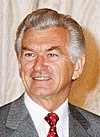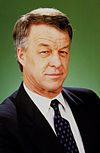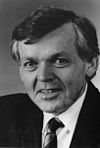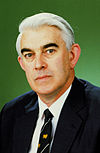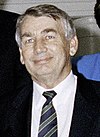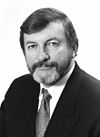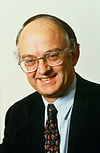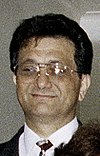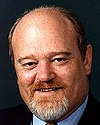
Robert James Lee Hawke was an Australian politician who served as the 23rd prime minister of Australia from 1983 to 1991, holding office as the leader of the Australian Labor Party (ALP). He was a member of parliament (MP) for the division of Wills from 1980 to 1992.

Paul John Keating is an Australian former politician who served as the 24th prime minister of Australia from 1991 to 1996. A member of the Australian Labor Party (ALP), he previously served as treasurer of Australia in the Hawke Government from 1983 to 1991 and as deputy prime minister of Australia from 1990 to 1991.

Simon Findlay Crean is an Australian politician and trade unionist. He was the Member of Parliament for Hotham from 1990 to 2013, representing the Labor Party, and served as a Cabinet Minister in the Hawke, Keating, Rudd and Gillard Governments. He was the Leader of the Labor Party and Leader of the Opposition from November 2001 to December 2003.
The Fourth Fraser Ministry was the 53rd ministry of the Government of Australia. It was led by the country's 22nd Prime Minister, Malcolm Fraser. The Fourth Fraser Ministry succeeded the Third Fraser Ministry, which dissolved on 3 November 1980 following the federal election that took place in October. The ministry was replaced by the First Hawke Ministry on 11 March 1983 following the federal election that took place on 5 March which saw Labor defeat the Coalition.
The First Hawke Ministry (Labor) was the 54th ministry of the Government of Australia. It was led by the country's 23rd Prime Minister, Bob Hawke. The First Hawke Ministry succeeded the Fourth Fraser Ministry, which dissolved on 11 March 1983 following the federal election that took place on 5 March which saw Labor defeat Malcolm Fraser's Liberal–National Coalition. The ministry was replaced by the Second Hawke Ministry on 13 December 1984 following the 1984 federal election.
The Second Hawke Ministry (Labor) was the 55th ministry of the Government of Australia. It was led by the country's 23rd Prime Minister, Bob Hawke. The Second Hawke Ministry succeeded the First Hawke Ministry, which dissolved on 13 December 1984 following the federal election that took place on 1 December. The ministry was replaced by the Third Hawke Ministry on 24 July 1987 following the 1987 federal election.
The Third Hawke Ministry (Labor) was the 56th ministry of the Government of Australia. It was led by the country's 23rd Prime Minister, Bob Hawke. The Third Hawke Ministry succeeded the Second Hawke Ministry, which dissolved on 24 July 1987 following the federal election that took place on 11 July. The ministry was replaced by the Fourth Hawke Ministry on 4 April 1990 following the 1990 federal election.
The First Keating Ministry (Labor) was the 58th ministry of the Government of Australia. It was led by the country's 24th Prime Minister, Paul Keating. The First Keating Ministry succeeded the Fourth Hawke Ministry, which dissolved on 20 December 1991 following the successful leadership challenge by Keating and subsequent resignation of Bob Hawke as Prime Minister. The ministry was replaced by the Second Keating Ministry on 24 March 1993 following the 1993 federal election.

The First Howard Ministry was the 60th ministry of the Government of Australia. It was led by the country's 25th Prime Minister, John Howard. The First Howard Ministry succeeded the Second Keating Ministry, which dissolved on 11 March 1996 following the federal election that took place on 2 March which saw the Coalition defeat Paul Keating's Labor Party. The ministry was replaced by the Second Howard Ministry on 21 October 1998 following the 1998 federal election.
The following lists events that happened during 1990 in Australia.
A Kirribilli agreement, in Australian politics, is an agreement, typically confidential, between a leader and their deputy for the handing over of power on the satisfaction of an agreed precondition.
Peter Staples is an Australian former politician for the Australian Labor Party. He was first elected to Parliament in 1983 as the Member for Diamond Valley. When Diamond Valley was abolished in 1984, Staples transferred to the newly created Jagajaga, essentially the western half of his old electorate. In 1987, he was appointed Consumer Affairs Minister by Prime Minister Bob Hawke in his third ministry. Staples would remain a junior minister for nearly six years, serving as Minister for Housing and Aged Care and later Aged, Family and Health Services in the Hawke and Keating Ministries.

The 1987 Australian federal election was held in Australia on 11 July 1987, following the granting of a double dissolution on 5 June by the Governor-General Sir Ninian Stephen. Consequently, all 148 seats in the House of Representatives as well as all 76 seats in the Senate were up for election. The incumbent Australian Labor Party, led by Prime Minister Bob Hawke, defeated the opposition Liberal Party of Australia, led by John Howard and the National Party of Australia led by Ian Sinclair. This was the first, and to date only, time the Labor Party won a third consecutive election.
Ross Vincent Free is a former Australian politician who served as a Labor member of the Australian House of Representatives representing the seat of Macquarie from 1980 until 1984, then Lindsay from 1984 until 1996. He served as a minister from 1990 until 1996 in both the Hawke and Keating ministries.

The Hawke–Keating Government is an all-encompassing term to describe the duration of the Hawke Government and the Keating Government, which together spanned from 11 March 1983 to 11 March 1996. Both governments were formed by the Australian Labor Party, and were led from 1983 to 1991 by Bob Hawke as Prime Minister, and from 1991 to 1996 by Paul Keating as Prime Minister, with Keating serving as Treasurer throughout the Hawke Government. During the Hawke–Keating Government, the Labor Party won five successive federal elections, its most electorally successful period to date; the 13-year uninterrupted period of government also remains the Labor Party's longest spell in power at the federal level.

The Hawke Government was the federal executive government of Australia led by Prime Minister Bob Hawke of the Australian Labor Party (ALP) from 1983 to 1991. The Government followed the Liberal-National Coalition Fraser Government and was succeeded by another Labor administration, the Keating Government, led by Paul Keating after an internal party leadership challenge in 1991. Keating served as Treasurer through much of Hawke's term as Prime Minister and the period is sometimes termed the Hawke-Keating Government.

The Keating Government was the federal executive government of Australia led by Prime Minister Paul Keating of the Australian Labor Party from 1991 to 1996. The Government followed on from the Hawke Government after Paul Keating replaced Bob Hawke as Labor leader in an internal party leadership challenge in 1991. Together, these two governments are often collectively described as the Hawke-Keating Government. The Keating Government was defeated in the 1996 federal election and was succeeded by the Howard Coalition government.
The Kirribilli Agreement of 1988 was a secret meeting between the Australian Prime Minister Bob Hawke and Treasurer Paul Keating. The two men met at Kirribilli House, the Prime Minister's official Sydney residence, to make an agreement as to when Hawke would hand over the leadership of the Australian Labor Party.

A leadership spill of the Australian Labor Party (ALP), the party of government in the Parliament of Australia, was held on 19 December 1991, the second spill in a year. Backbencher and former Treasurer Paul Keating defeated Prime Minister Bob Hawke, who had led Labor for eight and a half years.

A leadership spill in the Australian Labor Party, the party of government in the Parliament of Australia, was held on 3 June 1991. It was the first of two ballots that year with Prime Minister Bob Hawke surviving the ballot against Treasurer Paul Keating, who then went to the backbench.

